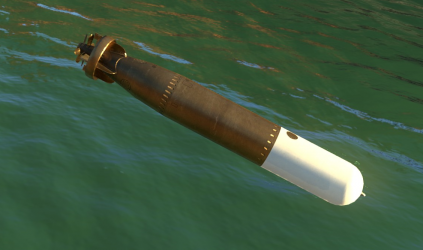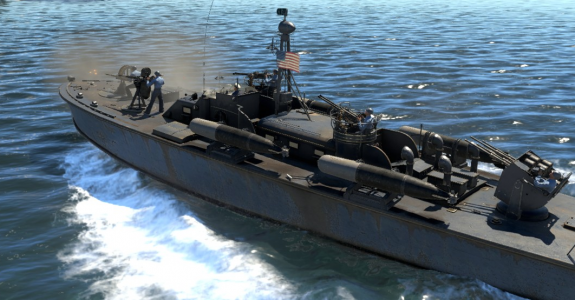22.5-inch Mk.13
Contents
Description
The Mk.13 (569 mm) torpedo was a guinea pig of a torpedo having been the subject of testing and modification since 1925. Used early in World War II, this torpedo failed to operate properly approximately 70% of the time with problems of running cold (propeller mechanism failed to start), sinking, not running true (deviating path), improper depth, running on the surface or porpoising (continuous jumping out of the water) due to improper water contact. Aircraft were required to fly extremely slow and low when dropping the torpedo as to not damage it on impact with the water and to provide the most stable drop possible, unfortunately, this put the torpedo bomber in a bad position of being an easy target for anti-aircraft guns mounted on enemy ships.
Extensive testing in 1942 determined that the low and slow approach to the Mk.13 launch was actually counterproductive as it caused the torpedo to "belly-flop" on the water resulting in damage sustained to its internal components. New modifications were tested which replaced fragile parts and components which were susceptible to damage upon impact with the water.[1] Updates to the torpedo allowed it to be safely dropped from a higher altitude and at faster speeds. By 1944 the Mk.13 was essentially a brand new torpedo and was accepted as the best aircraft torpedo in the U.S. inventory at that time and was credited with the sinking of the Japanese battleship Yamato.[2]
Later after World War II, there came a need for river patrol boats to be outfitted with torpedo launchers. The Mk.13 was the ideal torpedo to fulfil this need due to its short stature (compared to other torpedoes) and excelled in a shallow launch and run which afforded it to operate in shallow waters without hitting the bottom. Opportunities for sea use on smaller vessels were available in shallow areas where larger ships and torpedoes could not operate.
Vehicles equipped with this weapon
General info
The aircraft torpedo Mk.13 is typically carried on attack-type aircraft, however, there are a few light bombers which can also be outfitted with them. The design of the Mk.13 departed from conventional torpedo design for submarines and destroyers to accommodate being delivered by aircraft and being dropped.[2] Due to the short and stocky size of the torpedoes, they were also ideal to be outfitted on motor torpedo boats where they could either be launched from tubes or just rolled off the side of the boat for more stealthy approaches.
The appearance of this torpedo is similar to many others in that it has the appearance of a mini-submarine which contains an engine, fuel and steering devices. At almost one ton in weight, 600 lbs of it is the detachable warhead which is filled with the highly explosive Torpex.[1]
The Mk.13 torpedo was specifically designed to be used from an aerial platform with a range of 5.7 km with an in-water speed of almost 67 km/h. The Mk.13 designation applies to the entire torpedo assembly as a whole, however, portions of the torpedo (warhead, gyroscope and other sub-assemblies) will have their own mark and mod designations.
Effective damage
The Mk.13 torpedo had a large high-explosive warhead compared to the Mk.VII which was frequently used at the time. The Mk.13 had a 600 lb (270 kg) Torpex (Torpedo Explosive) warhead compared the Mk.VII's 466 lb (211 kg) warhead. Torpex was an explosive which was about 50% more powerful than TNT by mass alone as this mixture contained 40% TNT, 42% RDX and 18% powdered aluminium. While not as fast nor had as long of range as other torpedoes, the Mk.13 was used effectively at night when stealthy operations from PT boats which took place requiring torpedoes to reach the target with the least amount of warning. Aerial operations took advantage of the slower torpedo by dropping it from a higher altitude, increasing its time in the air and getting it closer to the target before it entered the water.[1]
Comparison with analogues
- Mk.13/44 : This is the same torpedo as the Mk.13 (569 mm), however, it has been outfitted with the frangible drag ring and box stabilizer to allow for higher drops at faster speeds.[1]
Usage in battles
The upgraded Mk.13 torpedo can be utilised against any target which is in the water which can include ships, boats, tanks (at the water's edge), boat-planes or even structures. Due to the higher altitude in which it can be dropped from, the delivering bomber can make a safer approach, release and get-away avoiding ship-board anti-aircraft fire and fighters patrolling around ships.
Pros and cons
Pros:
- Great run distance
- Decent max altitude for successful torpedo launch
Cons:
- Aircraft typically only carry one or two at a time
- Slow, given enough distance a ship can avoid the torpedo
- Aircraft must be low and slow for launch to ensure proper torpedo run
History
The first purpose-built aerial torpedo, the Mark 13 had a long way to go before seeing combat and even longer way to become an effective combat weapon. The Mark 13 originated from a 1925 design study by the United States Navy. However, to the detriment of the design, it ended in development hell for almost two decades before entering service[3]. The lengthy development cycle came from the changing requirements of the United States Navy. The first attempt was the “Project G-6” design which was cancelled in 1926 just a year after it entered development for a plan make aerial version of the WWI-era Mark 7 torpedoes. In 1927, the Navy changed their mind again and revived the G-6 project which was designated the Mark 13 in August of 1930. By this point, development of the Mark 13 remained uncertain due to the emergence of dive bombers led and the program was cancelled again in October. It was then revived yet again in July of 1931 and in 1936 it was accepted into service. But the acceptance of the Mark 13 would be the ends of its problems[2].
The production of all torpedo types during the inter-war period was all done by a single factory to supply the entire US Navy, which naturally created a backlog as they couldn’t meet the target goals for torpedo production[4]. Eventually the United States had to arrange for other companies including Pontiac and International Harvester alongside production at the Naval Torpedo Station in Newport, Rhode Island[3]. Even before the US entered the war the flaws of the Mark 13 began to emerge. A training in July 1941 by VT-6 had only one of the 10 torpedoes launched perform a success run with 5 going off course and the remaining four sinking[2]. The problems with the Mark 13 only became more obvious when the United States entered World War II with 39 out of 41 torpedo bombers that were lost at the 1942 Battle of Midway not even scoring a single hit with their torpedoes. In mid-1943, a study of 105 torpedoes dropped from speeds over 150 knots only 31% of torpedoes dropped worked as intended. 36% didn’t even start, 20% sank, 20% had poor deflection performance, 18% did have run at the right depth and 2% ran on the surface. Due to 12 known defects existing in the Mark 13, the Navy decided to develop the Mark 25 to replace with a more effective aerial torpedo[3].
Due to shortages of the Mark 8 and Mark 10 torpedoes for PT boats in the Pacific Theater, and needing a weapon to counter Imperial Japanese Navy destroyers and cruisers, the Mark 13 was pressed into service on these craft in 1944[5]. The Mark 13’s light weight meant it save as much as 1,400 pounds when installed on PT boats and could be simply rolled over the sides from launch racks instead of using launch tubes. As a result, the Mark 13 did not risk causing burned grease trail that would expose the boat’s firing position. The Mark 13’s final benefit in the PT boat role was its larger 600 pound warhead loaded with torpex which was 50% more powerful than TNT by mass. The Mark 13 had some drawbacks however. Primarily, it was slower than regular torpedoes and had a shorter range, but these were not seen as significant problems for PT boats which relied on stealth to attack large ships[3].
Despite its troubled history, the Mark 13 was the last aerial torpedo to be used in combat and the last torpedo of any type used by the US Navy. Its final mission occurred during the Korean War where 8 AD-4 Skyraiders launched from USS Princeton flew to destroy Hwachon Dam in South Korea which the North Koreans were using to hinder the movement of United Nations Command floating barges downstream[6]. Due to the improvements made to the design during World War II, the Mark 13 had only two of the 8 torpedoes fail and the remain 6 were more than enough to destroy the dam.
The Mark 13 was unusual for aerial torpedoes in its long but squat dimensions of 22.5 inches in diameter and 13 feet 5 inches. The original Mod 0 torpedoes weighed 1,949 pounds and had between 404 and 392 pounds of TNT, a range of 5,700 yards and a speed of 30 knots. The Mark 13 had a negative buoyancy of 523 pounds, used a Mark 12 Mod 1 gyro for guidance, and was powered by a wet-heater steam turbine. The latter Mod 10 torpedoes were 13 feet 9 inches long and 2,216 pounds. The Mod 10 could accommodate 603 pounds of TNT, 606 pounds of Torpex, or 600 pounds of High Blast Explosive which was developed as a less sensitive version of Torpex[2].
Media
- Images
Mk.13 (569 mm) mounted on the deck of a Thunderbolt (PT-556)
See also
Links to the articles on the War Thunder Wiki that you think will be useful for the reader, for example:
- reference to the article about the variant of the weapon;
- references to approximate analogues by other nations and research trees.
External links
- NavWeaps Website [World War II Torpedoes of the United States]
- Flight Journal Website [Iconic Firepower: The Outstandingly Bad Mark 13 Torpedo]
- Ordnance Pamphlet No. 629(A) [U.S. Navy Torpedoes Mark 13, B-1 & 2 July 1942]
- NAVPERS 10826 [Naval Airborne Ordnance], p. 153-166
References
- ↑ 1.0 1.1 1.2 1.3 U.S. Naval and Systems Ordnance Command. (1952). Naval Airborne Ordnance (OP 10826)
 .
.
- ↑ 3.0 3.1 3.2 3.3 Mark 13 Torpedo-Wikipedia https://en.wikipedia.org/wiki/Mark_13_torpedo
- ↑ The Mark 14 Torpedo - Failure is Like Onionshttps://www.youtube.com/watch?v=eQ5Ru7Zu_1I&list=PLMK9a-vDE5zGO_0h6YbwjHlPKl6Rc3ofN&index=20
- ↑ Pacific War Journal http://pwencycl.kgbudge.com/U/s/US_Mark_13_torpedo.htm
- ↑ Hwacheon Dam-Wikipedia https://en.wikipedia.org/wiki/Hwacheon_Dam






